by David Greer
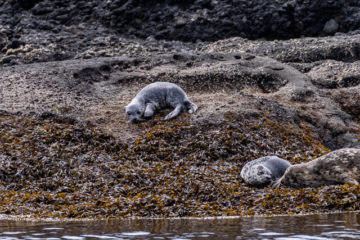
Camera in hand, nature photographer Myles Clarke walked along the pebble beach on South Pender Island watching for great blue herons, bald eagles, buffleheads, cormorants—any of the species likely to frequent waters close to the shore of a Salish Sea island on a summer’s day. He listened carefully for their familiar calls, but what he heard instead was plaintive cries unlike any bird’s, eerily like a child crying for its mother—“Ma-a-a! Ma-a-a!” Inexplicably, they seemed to be coming from the direction of a tiny islet in the bay, a hundred yards from shore, not the kind of place you’d expect to find a crying infant.
The source of the calls was indistinct against the black rock, so Myles pointed his 600 mm telephoto lens for a better look. What he saw was fascinating and unsettling. Three harbour seals were hauled out on the islet—a mother and her newborn side by side and, several feet away, a second pup, the source of the loud and piteous cries.
On return visits the next couple of days, Myles became increasingly concerned that the crying seal was in trouble. It seemed to approach mothers of other pups (there were several by now) as if attempting to suckle, and on each occasion the adult would chase the crying pup away and open its jaws as if threatening to bite. On the third day, the pup seemed to have become weaker and its cries fainter.
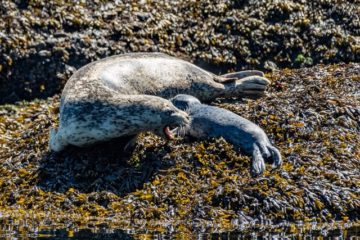
Concerned that the pup might have lost its mother, Myles asked local residents for advice. One of them suggested calling the wildlife rescue centre on nearby Salt Spring Island, one of several west coast organizations that come to the aid of marine mammals that have been injured, abandoned or tangled in fishing nets or packing material. On receiving his call, Island Wildlife Natural Care Centre (locally known as Island Wildlife Rescue) immediately dispatched a boat to investigate.
Concluding that the seal pup, less than a week old, had indeed been abandoned, the rescue volunteer gently lifted it into a net and transported it for assessment and stabilization to the Salt Spring Island facility, where staff worked to rehydrate the pup and gave her a name: Water Silk.
§ § §
The Salish Sea consists primarily of a broad strait sheltered from the northern Pacific Ocean by Canada’s Vancouver Island, and its most common marine mammal is the harbour seal—a small “true seal” (no external ears) and the most widely distributed pinniped (a group that includes walruses, eared seals, and true seals) in the world, with populations scattered throughout the oceans of the northern hemisphere.
If you live near a shore frequented by harbour seals and have ever chanced to watch a Labrador retriever at the water’s edge barking at a curious seal staring back wide-eyed from a few feet offshore, you might imagine they’re separated cousins, which in a way they are. Like other marine mammals (sea lions, sea otters, porpoises, dolphins, and whales), seals evolved from land mammals, which in turn had evolved from sea creatures. Such strange and wonderful things happen over the course of a few hundred million years of evolution. By comparison, the evolution of homo sapiens over the past couple of hundred thousand years has been like the momentary flash of a shooting star as ancient constellations wheel though a cloudless night—something to bear in mind when we start taking ourselves a little too seriously.
Even the bark of a harbour seal sounds a bit like that of a Labrador, and their common ancestry as land mammals is reflected in the seal’s need to surface to breathe, though a harbour seal can dive more than a third of a mile below the surface and stay submerged for up to thirty minutes. Also in common with the Labrador, the seal is prone to distemper infections like the one that not so many years ago wiped out half the harbour seals in the North Sea.
The highest density of harbour seals in the world occurs in the Salish Sea, but that wasn’t always the case. Subsistence fishing by indigenous hunters before white contact had little effect on the overall seal population. That changed rapidly during the late nineteenth and early twentieth centuries, when harbour seals were hunted for their pelts and, in addition, were considered such a nuisance by commercial and sport fishermen that the government offered a bounty for their killing. So enthusiastic was the response that almost 115,000 bounties were paid in British Columbia between 1879 and 1970, and over 170,000 harbour seal pelts were sold. It became common for fishboats to carry rifles and “seal bombs” (a type of grenade) to dispatch or deter seals. (The shooting of orca whales as late as the 1960s in British Columbia was condoned for the same reason.)
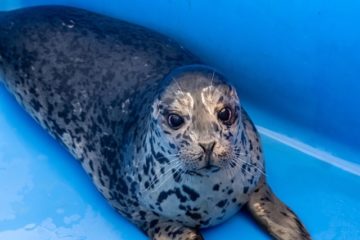
If the gradual elimination of the harbour seal was the goal, this sustained hunting party must have been counted a grand success. By the time the federal government protected the harbour seal in 1970 (the year of the first ‘Earth Day’ and a turning point in environmental activism), the species’ population in the province’s waters had been reduced from a population of between 65,000 and 110,000 in the late 1800s to fewer than 10,000 by the late 1960s (John Ford, Marine Mammals of British Columbia, 394). In the years since, the population has gradually rebounded to something close to its historic numbers.
The hunting of seals is a perennially sensitive topic in Canada, where the slaughter of harp and hooded seals for their pelts on the eastern and northern coasts triggers international controversies on slow news days. Not surprisingly, then, periodic calls for a cull of harbour seal populations have largely gone unheeded by Canada’s Department of Fisheries and Oceans.
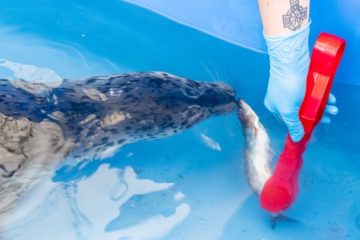
Advocates of a seal cull who suggest the current abundance of harbour seals in the region is out of whack conveniently forget or are unaware that the numbers are probably no greater than those that preceded decades of killings sanctioned by law. That may be a result of what Callum Roberts (The Ocean of Life: The Fate of Man and the Sea, 4) refers to as the shifting baseline syndrome, in which we take for granted conditions that a couple of generations ago would have seemed inconceivable. In the good old days, the weights and numbers of prized fish were many times what fishermen today consider ‘trophy fish’. First Nations elders in this region recall times when the abundance of spawning salmon was so great that a man could walk across a stream on the backs of fish migrating upriver to lay or fertilize their eggs. That may sound like an exaggeration, but probably not much of one, given the efficiency with which, through negligence or with purpose, ‘modern’ fishing practices and other human interventions have eroded the populations and size of targeted species.
Harbour seals still figure prominently among the usual suspects for the decline in populations of Pacific salmon species, particularly the chinook salmon that constitute virtually the entire diet of the Salish Sea’s three resident orca pods, but the seal’s reputation as a salmon-stalker may be largely undeserved. Although harbour seals prey fairly heavily on salmon entering rivers to spawn, salmonids represent only about four percent of their overall diet, which largely consists of herring and hake, a salmon predator (Ford, supra). If the greater portion of a seal’s diet consists of salmon predators rather than salmon, a seal cull arguably defeats the stated purpose of conserving salmon.
An argument frequently put forward by advocates of a cull is that seal populations need to be reduced to restore the balance of nature. The problem with this rationale is that it’s hard to conceive of nature being in balance anywhere where there’s a strong human influence. Ever since human society developed the tools to dominate and desecrate ecosystems, most especially since the beginning of the industrial era, people appear to have taken every opportunity to upend the balance of nature, while claiming that some Creator or other (identity dependent on religious belief) had said it was meet and right so to do.
In any case, the population of harbour seals in the Salish Sea has returned to roughly what it likely was prior to the nineteenth and twentieth centuries, which suggests that whatever balance might have been said to exist has merely been restored. If saving salmon is the goal, it might seem more to the point to consider other threats, such as open net salmon farms that infect juvenile wild salmon with sea lice, or forest companies with a lengthy history of stripping riparian areas of the shade essential for salmon spawning, or whomever among us cares to take credit for rewarming the ocean and river waters that the most recent ‘ice age’ cooled enough to enable Pacific salmon to inhabit them.
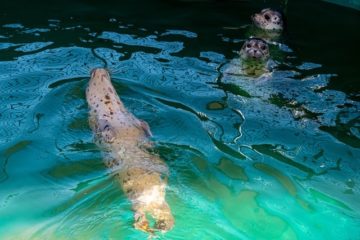
The oceans are sometimes described as humanity’s last frontier. While this is largely true from a scientific perspective, society as a whole hasn’t let scientific uncertainty delay the despoiling of marine ecosystems, first (and still) through overfishing, then by inundating the ocean with plastic refuse that entangles marine animals and breaks down into particles small enough to contaminate even plankton, and most recently through acidification and warming. Every one of us is to some degree complicit, especially if we live in a ‘developed’ nation, so finger-pointing without taking responsibility is hardly productive. Pogo’s all too obvious observation that “We have met the enemy and he is us” seems as relevant today as it was when he spoke it, with a little help from Walt Kelly, in time for the first Earth Day in April 1970.
Callum Roberts concisely sums up the overall effect in Ocean of Life: “The world’s oceans have been very stable for most of civilized history… [but] the last two hundred years have seen marine habitats wiped out or transformed beyond recognition. And with an accelerating tide of human impact, the oceans have changed more in the last thirty years than in all of human history before. In most places the oceans have lost up to 75 percent of their megafauna—large animals such as whales, dolphins, sharks, rays, and turtles—as fishing and hunting spread in waves across the face of the planet.” (2-3)
The harbour seals along the Pacific coast of Canada are by all accounts doing relatively well, but only as a result of legal protection from persistent efforts at extermination. But if the seals are doing so well, why bother rescuing abandoned pups instead of letting nature take its course? If the majority of seal pups rescued have lost their mothers, sad as that may seem, should we be replacing indifferent nature with our own sympathies for cute creatures, and in our own way altering the balance of nature?
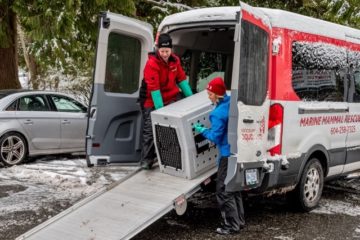
Some critics of wildlife rescue argue that we should not be expending precious resources on individual animals while habitats are being destroyed and entire species fade into extinction as a result of human negligence or malice. All very true, except the argument does invite a counterargument invoking tilting at windmills (government inertia, corporate obligation to shareholders). It also overlooks human passion. Wildlife rescue organizations represent the dedicated commitment of tireless volunteers. An Island Wildlife Rescue representative explained to me the organization’s raison d’être: “We treat all animals equally because they all suffer equally. We see animals as independent lives, not as populations. If we can prevent the needless suffering of a single animal, then we have done important work.”
Does it matter that this looks like a mission statement based on emotions rather than science? The same might be said about the rationale for culling seals: seals eat salmon; we need to catch salmon to feed our families; we feel threatened by uncontrolled and voracious seals; shooting seals is the obvious solution. Rescuing a few hundred seals is no parallel with slaughtering tens of thousands, but there’s no doubt that strong feelings are a primary incentive for either course of action.
What truly distinguishes organizations like Island Wildlife Rescue and the Marine Mammal Rescue Centre and like-minded organizations around the globe is the support they attract from an army of volunteers. At the very least, it seems an important gesture towards offsetting much of humanity’s long history of callous indifference or deliberate cruelty towards other species with which we share this planet.
§ § §
A charitable organization that operates seven days a week, 24 hours a day, responding to calls from all over the Canadian Gulf Islands and beyond, Island Wildlife Rescue cares for over 500 wild birds and mammals every year, including between 50 and 100 harbour seal pups. Island Wildlife Rescue works closely with other local and international wildlife rehabilitation centres and veterinary clinics, including the Vancouver Aquarium’s Marine Mammal Rescue Centre, the only facility in Canada devoted exclusively to the rehabilitation of marine mammals. The aquarium was Water Silk’s next destination, courtesy of a local airline that provides free cargo space for animal rescues—in this case a short flight from the Gulf Islands to the city of Vancouver.
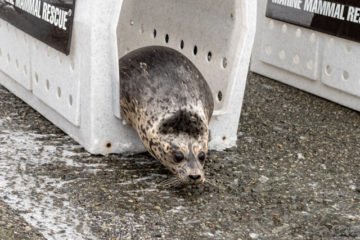
The Vancouver Aquarium’s Marine Mammal Rescue Centre admits a wide range of creatures in need of care—including harbour porpoises, sea lions and sea otters, as well as elephant and fur seals—but harbour seals make up by far the largest number of rescues by species. In 2022, the Centre fielded 266 calls about harbour seals and admitted 97, of which 37 had been rescued and then stabilized by Island Wildlife Rescue. Island Wildlife Rescue staff explained to me that seal pups may need rescuing for any number of reasons, including abandonment by first-time mothers, premature birth resulting in separation from the mother, separation from foraging mothers by tides or time, death of the mother as a result of predation by transient orcas or gunshot or entanglement in fishing nets, predation of pups by eagles or river otters, infectious diseases or congenital defects, and intervention by humans, well-meaning or otherwise, whose presence may frighten mothers away from their pups.
The survival chances of an abandoned newborn seal in nature are slim. A pup spends four to six weeks with its mother, doubling or tripling its weight on what may be the richest source of food in the ocean— mother’s milk that is more than fifty percent fat. A seal pup relies on its parent to learn how and what to hunt, a mentoring role that forms a significant component of the Marine Mammal Rescue Centre’s rehabilitation program.
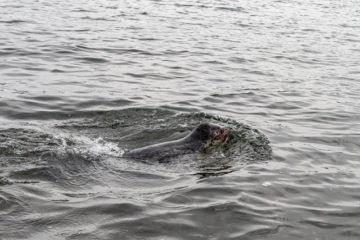
Harbour seal pups weigh only about twenty to twenty-five pounds at birth (an adult can reach over three hundred), and Water Silk weighed not much more than her birth weight at the time of her transfer to the rescue facility. For the first twenty days after her arrival at the Centre last July, Water Silk was fed a rich formula five times a day before gradually being introduced to herring and then sent to “fish school” to be weaned off formula and taught to eat a seal’s natural prey. Once the pup learned to eat fish on her own, she was taken out of isolation and introduced to other seal pups. Myles Clarke, the nature photographer who first noticed Water Silk in trouble and initiated the rescue process, followed her progress closely and documented the process with dozens of photographs, including those accompanying this article.
Lindsaye Akhurst, the manager of the Vancouver Aquarium’s Marine Mammal Rescue Centre, explained to me that seal pups don’t habituate well to human contact, but about eighty percent of those in the care of the rescue centre survive until their release, typically about three to four months after their admission. As long as they have learned to hunt and feed successfully, it seems not to matter whether they are released close to the location of their birth. Consequently, though Water Silk began her rehabilitation journey on South Pender Island some miles west of Vancouver, she began her new life in the wild last December by plunging from the North Vancouver shore into Burrard Inlet, fattened to two or three times her size when rescued, and newly versed in the hunting skills needed to ensure she will never again go hungry.
§ § §
Thanks to Myles Clarke (Instagram @emylesclarke) for following and documenting Water Silk’s journey for five months from rescue to release and for generously sharing his photos for this article.
